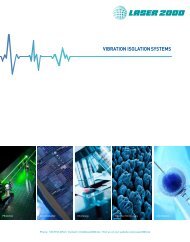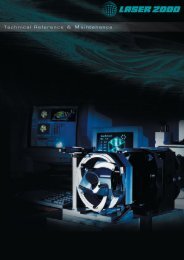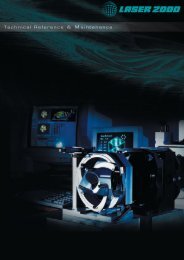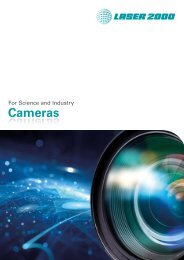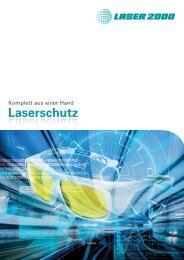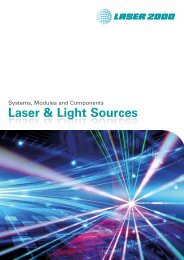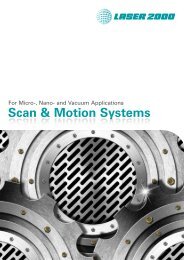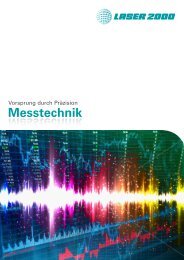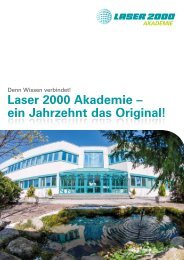Semrock Master Catalog 2018
Semrock Master Catalog 2018
Semrock Master Catalog 2018
You also want an ePaper? Increase the reach of your titles
YUMPU automatically turns print PDFs into web optimized ePapers that Google loves.
Fluorophores<br />
Single-band<br />
Sets<br />
Multiband<br />
Sets<br />
VersaChrome Edge TM Tunable Filters<br />
TECHNICAL NOTE<br />
Tunable Edge Filters<br />
As fluorescence technology evolves, so too must the optical filters that are key<br />
TLP01-628<br />
TLP01-790 to detection. Almost every new fluorophore requires its own bandpass filter<br />
TSP01-628<br />
TSP01-790<br />
to yield the best brightness or contrast. That optimal bandpass may need to<br />
change in order to maximize signal to noise when used in conjunction with<br />
other fluorophores. The typical approach to designing a new optical system or<br />
developing a new test (new fluorophore, chemistry, etc.) is to try an assortment<br />
TLP01-561<br />
TLP01-704<br />
TSP01-561<br />
TSP01-704<br />
of our catalog bandpass filters that span the right wavelength range, testing and<br />
500 550 600 650 700 750 800 selecting the one that performs best in practice. While <strong>Semrock</strong>’s online plotting<br />
Wavelength (nm)<br />
and analysis tool SearchLight (searchlight.semrock.com) makes analysis and<br />
selection of the best prospective bandpass filters quick and easy, sometimes there is no perfect match to be found<br />
off the shelf.<br />
Until now, customers unable to find a catalog bandpass filter to meet their needs had to choose between using a<br />
suboptimal filter or purchasing a prototype run of a custom filter specification at significant cost. VersaChrome Edge<br />
tunable filters seek to fill that gap, allowing both researchers and instrument developers the ability to dynamically create<br />
and optimize their own bandpass filter shapes by combining three simple, versatile filters.<br />
100<br />
Cubes Laser<br />
Sets<br />
Full Spectrum<br />
Blocking Filter<br />
Wavelength (nm)<br />
+<br />
AOI: 0° – 60° AOI: 0° – 60°<br />
Tunable<br />
Long-pass Filter<br />
Wavelength (nm)<br />
+<br />
Tunable<br />
Short-pass Filter<br />
Wavelength (nm)<br />
=<br />
CWL and Bandwith<br />
Tunable bandpass filter<br />
Wavelength (nm)<br />
Transmission (%)<br />
90<br />
80<br />
70<br />
60<br />
60°<br />
0°<br />
50<br />
40<br />
30<br />
20<br />
10<br />
0<br />
550 590 630 670 710 750 790 830 870 910 950<br />
Wavelength (nm)<br />
Transmission (%)<br />
100<br />
90<br />
80<br />
70<br />
60<br />
60° 0°<br />
50<br />
40<br />
30<br />
20<br />
10<br />
0<br />
550 590 630 670 710 750 790 830 870 910 950<br />
Wavelength (nm)<br />
NLO<br />
Filters<br />
Individual<br />
Filters<br />
Dichroic<br />
Beamsplitters<br />
Tunable<br />
Filters<br />
With the VersaChrome Edge Tunable Filters, <strong>Semrock</strong> is offering a new way to prototype. Our three new families of filters<br />
AOI=35° AOI=40° AOI=45° AOI=50° AOI=55° AOI=60°<br />
are designed to work together to create the equivalent of a single passband filter in the visible or near infrared. This allows<br />
researchers and instrument designers alike to not only create the bandpass they need, but also to fine-tune edge positions<br />
and passband width to maximize brightness and contrast/signal-to-noise in real time, within their measurement setup.<br />
AOI=0° AOI=5° AOI=10° AOI=15° AOI=20° AOI=25° AOI=30°<br />
VersaChrome Edge tunable filters now allow you to design and optimize that perfect match for yourself – not on paper,<br />
but in the lab. The principle is simple: combine a long-wave pass filter with a short-wave pass filter to create the bandpass<br />
shape, and place in tandem with a full-spectrum blocking filter to provide extended out-of-band blocking. Together, the<br />
three filters perform like a traditional bandpass filter. The true elegance in the solution, however, lies in the edge filters<br />
themselves. By using our VersaChrome Edge tunable long wave pass and short wave pass filters, each edge can be angletuned<br />
to the precise cut-on or cut-off wavelength you need. Extended blocking down to UV wavelengths (250 nm) and up<br />
to the near infrared (NIR) can be provided by the addition of a full spectrum blocking filter.<br />
The result is that, by combining angle-tuned TLP and TSP filters with a full-spectrum<br />
blocking filter, it is possible to create a passband filter with any center wavelength over<br />
a range of wavelengths in the visible and near infrared, and a passband width (FWHM)<br />
of any width from ≤ 5 nm to at least 12% of the CWL (~75 nm at 628 nm,<br />
or 120 nm at 1000 nm). Edge filters are available to independently control each edge<br />
to generate the exact passband required with edge wavelengths from 400 nm to<br />
beyond 1100 nm.<br />
Edge Type Passband edge at (nm) Use these filters Set at these AOIs<br />
LWP 727.5 TLP01-790 45.58°<br />
SWP 768.5 TLP01-790 29.57°<br />
Transmission (%)<br />
100<br />
90<br />
80<br />
70<br />
60<br />
50<br />
40<br />
30<br />
20<br />
10<br />
0<br />
500 520 540 560 580 600 620 640 660 680 700<br />
Wavelength (nm)<br />
Input the desired Center-Wavelength (CWL) and Guaranteed-Minimum-Bandwidth (GMBW) or Full-Width-Half-Maximum<br />
(FWHM) to achieve a required passband using <strong>Semrock</strong>’s VersaChrome Edge Tunable Filter Calculator (see page 84)<br />
to calculate which filters and rotational angles will achieve this result.<br />
TLP01-628@60°<br />
TSP01-628@50°<br />
TLP01-628@40°<br />
TSP01-628@0°<br />
More<br />
82



